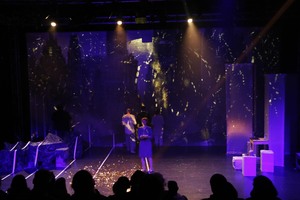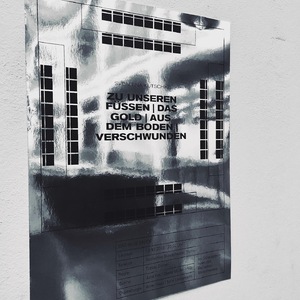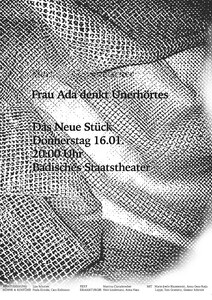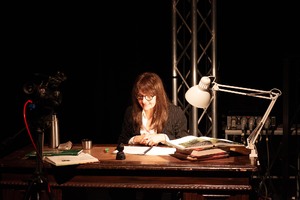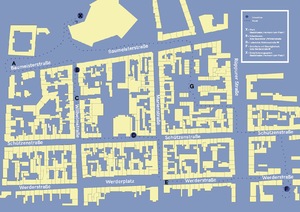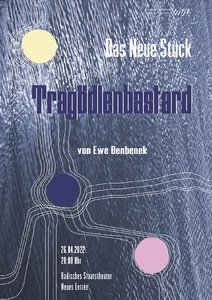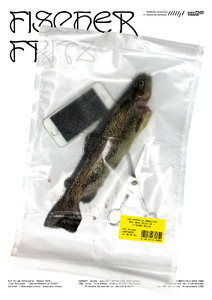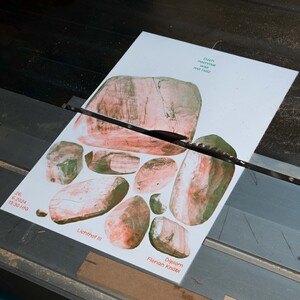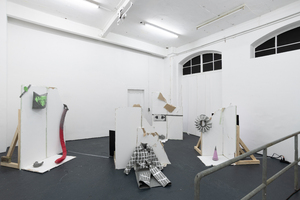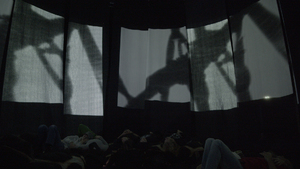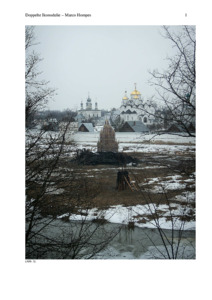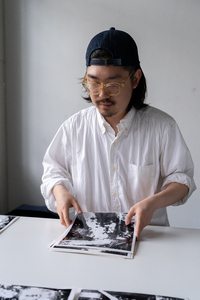Sets
281 Inhalte
- Seite 1 von 24
DNS #59
- Titel
- DNS #59
- Untertitel
- Worte
- Autor/in
- Beschreibung (de)
- In einer unbestimmten Zukunft sind nur noch Menschen mit einem besonderen Sprach-Gen privilegiert. Wer dieses Gen nicht aufweist, lebt außerhalb eines urbanen Zentrums, in Ruinen, mit rudimentärer Sprache, auf den evolutionären Grad eines Insekts reduziert. Wurm ist sprachlich begabt und schlüpft täglich durch die Absperrungen, die die Kolonien voneinander trennen, um im Zentrum zu arbeiten. Doch sein Vorgesetzter hat schon Verdacht geschöpft. Wie Sprache, Macht und die Herausbildung totalitärer Systeme zusammenhängen, davon schreibt Maria Milisavljevic in ihrem Stück Worte.
- Beschreibung (en)
- In an indefinite future, only people with a special language gene will be privileged. Those without this gene live outside an urban center, in ruins, with rudimentary language, reduced to the evolutionary level of an insect. Wurm is linguistically gifted and slips through the barriers separating the colonies every day to work in the center. But his superior has already become suspicious. Maria Milisavljevic writes about how language, power and the development of totalitarian systems are connected in her play Worte.
- Typ des Projekts/Werks
- Schlagworte
- Datierung
- 01.05.2019 - 15.05.2019
- Mitwirkende
- Sprache
- Ort: Institution
- Ort
- Studiobühne
- Stadt
- Land
- Beteiligte Institution(en)
- Bemerkungen
- Szenische Lesung und Autor*innengespräch
EINRICHTUNG Tobias Dömer
BÜHNE & KOSTÜME Lena Breitmoser, Carina Fenderich*
DRAMATURGIE Nele Lindemann MIT Emons, Hübschmann – Koch, Schumacher, Wagner
- Szenische Lesung und Autor*innengespräch
- Titel
- DNS #59
- Projektleiter/in
- Semester
- Studiengang
- Lehrveranstaltung
- Importiert am
- 19.12.2023
- Übergeordnete Sets
- 1
- Set enthält
- 0 9
DNS #63
- Titel
- DNS #63
- Untertitel
- Zu unseren Füßen, das Gold, aus dem Boden Verschwunden
- Autor/in
- Beschreibung (de)
- Ein Wohnhaus in Berlin: darin ein alter Trinker, ein lesbisches Paar, ein Geflüchteter, eine depressive Frau und ihr Ex-Mann. Im Stück „Zu unseren Füßen, das Gold, aus dem Boden verschwunden“ von Svealena Kutschke entspinnen sich im Alltag jener Figuren Fragen nach unserem Umgang mit dem Fremdem – sei es kultureller oder ideologischer Couleur. Die voyeuristische Situation, in welcher sich jegliche Erkenntnis nur durch die Blicke und Zuschreibungen der Nachbarn vollzieht, wurde hierfür in eine panoptische Szenografie übersetzt. Darin bewohnen die Schauspieler gemeinsam mit den Zuschauern Vorder- und Hinterhaus sowie die Seitenflügel, um so gleichsam eine diskursive wie affizierende Arena aufzuspannen. In der Mitte, ein Spiegel. Jene Leerstelle fungiert zugleich – in Form des Hinterhofs – als Austragungsort der einsamen Monologe wie auch als räumlicher Akteur für den, in der Besetzung nicht vorgesehenen, Flüchtling. Ob und wie jene Figur durch die Spiegelreflexion eine Stimme erlangt oder ob die Anwesenden in der Betrachtung lediglich auf sich selbst zurückgeworfen werden, bleibt bewusst eine offene, ungelöste Frage.
- Beschreibung (en)
- An apartment building in Berlin: an old drunk, a lesbian couple, a refugee, a depressed woman and her ex-husband. In Svealena Kutschke's play "Zu unseren Füßen, das Gold, aus dem Boden verschwunden" (At our feet, the gold that has disappeared from the ground), questions about how we deal with the foreign - be it of a cultural or ideological nature - arise in the everyday lives of these characters. The voyeuristic situation, in which all knowledge is only gained through the gazes and attributions of the neighbors, was translated into a panoptic scenography. In it, the actors inhabit the front and back houses as well as the side wings together with the audience in order to create an arena that is both discursive and affirmative. In the middle, a mirror. This empty space functions simultaneously - in the form of the backyard - as a venue for the solitary monologues and as a spatial actor for the refugee, who is not included in the cast. Whether and how this figure acquires a voice through the mirror reflection or whether those present are merely thrown back on themselves in the reflection deliberately remains an open, unresolved question.
- Typ des Projekts/Werks
- Schlagworte
- Datierung
- 13.12.2019
- Mitwirkende
- Sprache
- Ort: Institution
- Ort
- Studio
- Stadt
- Land
- Beteiligte Institution(en)
- Bemerkungen
- Szenische Lesung
Bühne: Julia Ihls und Gloria Müller, ADSZ Hfg Karslruhe WS 2019/2020
Regie: Tobias Dömer
Dramaturgie: Nele Lindemann, Anna Haas
Mit: Ute Baggeröhr, Marie-Joelle Blazejewski, Antonia Mohr, Sven Daniel Bühler, Timo Tank
- Szenische Lesung
- Titel
- DNS #63
- Projektleiter/in
- Semester
- Studiengang
- Lehrveranstaltung
- Importiert am
- 19.12.2023
- Übergeordnete Sets
- 1
- Set enthält
- 0 8
DNS #64
- Titel
- DNS #64
- Untertitel
- Frau Ada denkt Unerhörtes
- Autor/in
- Beschreibung (de)
- Das neue Stück „Frau Ada denkt Unerhörtes“ handelt von der ersten Programmiererin der Welt, Ada Lovelace. Es beschreibt Adas Leben in zwei Teilen: Einem biografischen aber stark verfremdeten ersten Teil, der durch seine Dialoge und Besetzung eher Traumhaft wirkt, und einem realistisch anmutenden zweiten Teil, in dem eine Zukunft erdacht wird, in der eine der Maschinen, die Ada einst erfand, die Macht über die Menschheit an sich nimmt.
Unsere Kulisse bestand aus einem leicht durchscheinenden Vorhang, der die Bühne in der Mitte teilt. Im ersten Teil des Stücks saßen die Zuschauer auf der Tribüne, für den zweiten Teil wechselten sie die Seite des Vorhangs und saßen dann auf niedrigen Podesten auf der Rückseite der Bühne.
Um die Traumhaftigkeit des ersten Teils darzustellen, zeigten wir dort nur die Schauspielerin von Ada vor dem Vorhang, die anderen drei Schauspieler, welche die Figuren der Mutter und zweier Puppen darstellten, befanden sich hinter dem Vorhang und waren nur durch Schatten auf diesem zu sehen. Das Stück lässt offen, ob Ada mit echten Personen spricht, ob die Ereignisse wirklich passiert sind, oder ob alles nur in Adas Kopf stattfindet. Dieses Verschwimmen aus Fiebertraum und Wirklichkeit wurde durch die Schatten auf dem Vorhang artikuliert. Um dem Publikum dennoch ein Gefühl für die echte Ada Lovelace zu geben, wurden immer wieder Fakten aus ihrem Leben auf den Vorhang projiziert.
Im zweiten, sehr realistisch anmutenden Teil, bei dem sich die Zuschauer auf der anderen Seite des Vorhangs befinden, stehen die drei Schauspieler nun auf der Publikumsseite des Vorhangs in den Rollen dreier Wissenschaftler. Ada, jetzt als Roboter, steht leicht beleuchtet hinter dem Vorhang und scheint wie eine Traumvorstellung trüb durch den Stoff. In dem Moment, als sie zu eigenständigem Leben erwacht, wechselt sie die Seite des Vorhangs, tritt aus dem Traum und übernimmt die Realität.
Neben dem Verschwimmen von Traum und Realität, ist das Stück ebenfalls geprägt von Machtverhältnissen: Im ersten Teil wird Ada von ihrer Mutter und ihren vielen Krankheiten dominiert und muss viel liegen. Die Schauspielerin sitzt im gesamten ersten Teil auf dem Boden. Der Schatten der Mutter hinter ihr ist groß und bedrohlich. Das Publikum sitzt in einer erhöhten Position auf der Tribüne und schaut auf Ada herab.
Im zweiten Teil übernimmt Ada in Form eines Roboters die Macht, das Publikum wird ihr untergeordnet und sitzt auf niedrigen Podesten fast auf dem Boden. Die Wissenschaftler werden von Ada überwunden und verlassen nach und nach den Lichtkegel der Bühne.
- Das neue Stück „Frau Ada denkt Unerhörtes“ handelt von der ersten Programmiererin der Welt, Ada Lovelace. Es beschreibt Adas Leben in zwei Teilen: Einem biografischen aber stark verfremdeten ersten Teil, der durch seine Dialoge und Besetzung eher Traumhaft wirkt, und einem realistisch anmutenden zweiten Teil, in dem eine Zukunft erdacht wird, in der eine der Maschinen, die Ada einst erfand, die Macht über die Menschheit an sich nimmt.
- Beschreibung (en)
- The new play "Frau Ada denkt Unerhörtes" is about the world's first female programmer, Ada Lovelace. It describes Ada's life in two parts: A biographical but heavily distorted first part, which seems rather dreamlike due to its dialog and cast, and a realistic-seeming second part, in which a future is imagined in which one of the machines Ada once invented takes power over humanity.
Our backdrop consisted of a slightly translucent curtain that divided the stage in the middle. In the first part of the play, the audience sat on the bleachers; for the second part, they changed sides of the curtain and then sat on low platforms at the back of the stage.
In order to portray the dreamlike nature of the first part, we only showed Ada's actress in front of the curtain; the other three actors, who played the characters of the mother and two puppets, were behind the curtain and could only be seen through shadows on it. The play leaves it open as to whether Ada is talking to real people, whether the events really happened or whether everything is just taking place in Ada's head. This blurring of fever dream and reality was articulated by the shadows on the curtain. In order to give the audience a feeling for the real Ada Lovelace, facts from her life were projected onto the curtain again and again.
In the second, very realistic-looking part, in which the audience is on the other side of the curtain, the three actors now stand on the audience side of the curtain in the roles of three scientists. Ada, now as a robot, stands slightly illuminated behind the curtain and seems to be clouding through the fabric like a dream. The moment she awakens to independent life, she changes sides of the curtain, steps out of the dream and takes over reality.
In addition to the blurring of dream and reality, the play is also characterized by power relations: In the first part, Ada is dominated by her mother and her many illnesses and has to lie down a lot. The actress sits on the floor throughout the first part. The shadow of her mother behind her is large and threatening. The audience sits in an elevated position on the stand and looks down on Ada.
In the second part, Ada takes over in the form of a robot, the audience is subordinated to her and sits on low platforms almost on the floor. The scientists are overcome by Ada and gradually leave the light cone of the stage.
- The new play "Frau Ada denkt Unerhörtes" is about the world's first female programmer, Ada Lovelace. It describes Ada's life in two parts: A biographical but heavily distorted first part, which seems rather dreamlike due to its dialog and cast, and a realistic-seeming second part, in which a future is imagined in which one of the machines Ada once invented takes power over humanity.
- Typ des Projekts/Werks
- Schlagworte
- Datierung
- 16.01.2020
- Mitwirkende
- Sprache
- Ort: Institution
- Ort
- Studiobühne
- Stadt
- Land
- Beteiligte Institution(en)
- Bemerkungen
- Szenische Lesung
Bühne & Kostüme: Paula Klotzki, Cara Kollmann
Regie: Liss Scholtes
Dramaturgie: Nele Lindemann, Anna Haas
Mit: Marie-Joelle Blazejewski, Anna Gesa-Raija Lappe, Tom Gramenz, Gunnar Schmidt
- Szenische Lesung
- Titel
- DNS #64
- Projektleiter/in
- Semester
- Studiengang
- Lehrveranstaltung
- Importiert am
- 19.12.2023
- Übergeordnete Sets
- 1
- Set enthält
- 0 8
DNS #65
- Titel
- DNS #65
- Untertitel
- Bookpink
- Autor/in
- Beschreibung (de)
- In sieben komisch-poetischen Miniaturen beschreibt Caren Jeß menschliche Abgründe im Gewand von Federtieren wie dem Dreckspfau, der Sumpfmeise, tanzenden Flamingos oder dem Bussard im Beton der Vernunft. Ein Stück voller Humor, subtilem Wortwitz und draller Situationskomik.
- Beschreibung (en)
- In seven comic-poetic miniatures, Caren Jeß describes human abysses in the guise of feathered creatures such as the peacock, the marsh tit, dancing flamingos or the buzzard in the concrete of reason. A play full of humor, subtle wordplay and gritty situation comedy.
- Typ des Projekts/Werks
- Schlagworte
- Datierung
- 27.02.2020
- Mitwirkende
- Sprache
- Dauer
- 1 Stunde 30 Minuten
- Ort: Institution
- Ort
- Studio
- Stadt
- Land
- Beteiligte Institution(en)
- Bemerkungen
- Szenische Lesung und Autor*innengespräch
Bühne/Kostüm: Paula Klotzki, Jana Trampert, Cara Kollmann, Julia Ihls
Dramaturgie: Nele Lindemann, Anna Haas
Regie: Tobias Döhmer
SchauspielerInnen: Antonia Mohr, Jannek Petri, Alisa Kunina, Pål Fredrik Kvale, Constantin Petry
Plakat: Julia Ihls
- Szenische Lesung und Autor*innengespräch
- Titel
- DNS #65
- Projektleiter/in
- Semester
- Studiengang
- Lehrveranstaltung
- Importiert am
- 19.12.2023
- Übergeordnete Sets
- 1
- Set enthält
- 0 4
DNS #66
- Titel
- DNS #66
- Untertitel
- FRAU VERSCHWINDET (VERSIONEN)
- Autor/in
- Beschreibung (de)
- Das neue Stück ist ein Format, in langjähriger Kooperation von Staatstheater Karlsruhe und HfG Karlsruhe, welches Texte zeitgenössischer Autor*innen behandelt. Die Studierenden entwickeln eine szenische Lesung, die normalerweise im Studio des Staatstheaters stattfindet.
Im Sommersemester 2020, entwickelte die Gruppe einen etwa einstündigen Audiowalk durch die Südstadt, der somit der Zeit - inmitten des Pandemiegeschehens – gerecht werden konnte.
Die Besucher*innen, die sich am Staatstheater sammelten, bekamen eine Karte mit verzeichneten Stationen, Kopfhörer, einen Mp3 Player und eine Sitzgelegenheit für unterwegs. Die von den Schauspielerinnen eingelesen Texte (Marie-Joelle Blazejewski
Lucie Emons), leiteten die Teilnehmer*innen audio-visuell durch die Straßen. Ergänzt wurde der Walk durch unterschiedliche Interventionen: z.B. das Verteilen von Joghurts, Aushänge von Wohnungen im Markler*innen Büro, Ruhestationen und ein Livemoment mit den Schauspiele-rinnen Lodi Doumit und Antonia Mohr in einem leerstehenden Ladenlokal in der Schützenstraße.
Inhalt:
„Frau Verschwindet (Versionen)“ von Julia Haenni ist 2019 im „Verlag der Autoren“ in Frankfurt am Main erschienen.
Eine Frau verschwindet aus ihrer Wohnung. Die Tür steht offen. Ist ihr Verschwinden Zufall, trifft die Frau die Entscheidung ihr Heim zu verlassen selbstbestimmt, ist etwas passiert…?
Die Autorin skizziert unterschiedliche Frauenstimmen, die mal mit sich selbst, mal untereinander in Dialog treten. Die Themen des Verschwindens und die Rolle der Frau in unserer Gesellschaft, sind herbei zentral.
- Das neue Stück ist ein Format, in langjähriger Kooperation von Staatstheater Karlsruhe und HfG Karlsruhe, welches Texte zeitgenössischer Autor*innen behandelt. Die Studierenden entwickeln eine szenische Lesung, die normalerweise im Studio des Staatstheaters stattfindet.
- Beschreibung (en)
- The new play is a format, in a long-standing cooperation between Staatstheater Karlsruhe and HfG Karlsruhe, which deals with texts by contemporary authors. The students develop a staged reading that normally takes place in the Staatstheater's studio.
In the 2020 summer semester, the group developed a one-hour audio walk through the Südstadt, which was thus able to do justice to the time - in the midst of the pandemic.
The visitors, who gathered at the Staatstheater, were given a map with marked stations, headphones, an mp3 player and a place to sit on the go. The texts read by the actresses (Marie-Joelle Blazejewski
Lucie Emons), guided the participants audio-visually through the streets. The walk was supplemented by various interventions: e.g. the distribution of yoghurts, notices of apartments in the Markler*innen office, resting stations and a live moment with the actresses Lodi Doumit and Antonia Mohr in a vacant store in Schützenstraße.
Content:
"Frau Verschwindet (Versionen)" by Julia Haenni was published in 2019 by "Verlag der Autoren" in Frankfurt am Main.
A woman disappears from her apartment. The door is open. Is her disappearance a coincidence, did the woman make the decision to leave her home on her own, did something happen...?
The author sketches different women's voices, who sometimes enter into dialog with themselves, sometimes with each other. The themes of disappearance and the role of women in our society are central.
- The new play is a format, in a long-standing cooperation between Staatstheater Karlsruhe and HfG Karlsruhe, which deals with texts by contemporary authors. The students develop a staged reading that normally takes place in the Staatstheater's studio.
- Typ des Projekts/Werks
- Schlagworte
- Mitwirkende
- Sprache
- Ort: Institution
- Ort
- Südstadt
- Stadt
- Land
- Beteiligte Institution(en)
- Internetlinks
- https://vimeo.com/484387006
Die Videoarbeit war Teil des Audiowalks und war vor dem Staatstheater auf einem alten Röhrenfernseher zu sehen.
- https://vimeo.com/484387006
- Bemerkungen
- Szenische Einrichtung& Ausstattung& Video:
Mascha Dilger
Nina Erika Eberle
Katja Koch
Josephine Leicht
Mariia Merkulova
Videoschnitt: Mariia Merkulova
Fotos: Felix Grünschloß
Grafik Flyer: Mascha Dilger
- Szenische Einrichtung& Ausstattung& Video:
- Titel
- DNS #66
- Projektleiter/in
- Semester
- Studiengang
- Lehrveranstaltung
- Importiert am
- 19.12.2023
- Übergeordnete Sets
- 1
- Set enthält
- 0 11
DNS #68
- Titel
- DNS #68
- Untertitel
- Tragödienbastard
- Autor/in
- Beschreibung (de)
- Es ist ein Akt der Emanzipation. Das mit dem Mühlheimer Dramatikerpreis gekrönte Stück erzählt in einem rhythmisch tobenden Redestrom davon, wie sich die Tochter polnischer Einwanderer und ihre „chosen sisters“ von der Last des Migrationsnarrativs befreien und zu dem werden, was sie eigentlich immer waren: Göttinnen.
Das Stück “Tragödienbastard” von Ewe Benbenek wurde im Wintersemester 2021/2022 im Rahmen des Seminars ‘Das neue Stück’ von Studierenden technisch und künstlerisch erarbeitet und in eine knapp zweistündige szenische Lesung umgesetzt. Das Projekt wurde von Constanze Fischbeck, Anna Haas und Eivind Haugland betreut sowie von Sandra Blatterer, welche in einem einwöchigen Lichtworkshop spannende Impulse zur Erarbeitung des Licht- und Bühnenkonzepts gab.
Im Anschluss an die szenische Lesung findet ein Nachgespräch mit der Autorin Ewe Benbenek und den Mitwirkenden statt.
- Es ist ein Akt der Emanzipation. Das mit dem Mühlheimer Dramatikerpreis gekrönte Stück erzählt in einem rhythmisch tobenden Redestrom davon, wie sich die Tochter polnischer Einwanderer und ihre „chosen sisters“ von der Last des Migrationsnarrativs befreien und zu dem werden, was sie eigentlich immer waren: Göttinnen.
- Beschreibung (en)
- It is an act of emancipation. The play, which was awarded the Mühlheim Dramatist Prize, tells the story of how the daughter of Polish immigrants and her "chosen sisters" free themselves from the burden of the migration narrative in a rhythmically raging stream of speech and become what they actually always were: Goddesses.
The play "Tragödienbastard" by Ewe Benbenek was technically and artistically developed by students in the winter semester 2021/2022 as part of the seminar 'Das neue Stück' and transformed into a staged reading lasting almost two hours. The project was supervised by Constanze Fischbeck, Anna Haas and Eivind Haugland as well as Sandra Blatterer, who gave exciting impulses for the development of the lighting and stage concept in a one-week lighting workshop.
The staged reading will be followed by a discussion with the author Ewe Benbenek and the participants.
- It is an act of emancipation. The play, which was awarded the Mühlheim Dramatist Prize, tells the story of how the daughter of Polish immigrants and her "chosen sisters" free themselves from the burden of the migration narrative in a rhythmically raging stream of speech and become what they actually always were: Goddesses.
- Typ des Projekts/Werks
- Schlagworte
- Datierung
- 26.04.2022
- Mitwirkende
- Sprache
- Dauer
- 2 Stunden
- Ort: Institution
- Ort
- neues Entrée
- Stadt
- Land
- Beteiligte Institution(en)
- Titel
- DNS #68
- Projektleiter/in
- Semester
- Studiengang
- Lehrveranstaltung
- Importiert am
- 20.12.2023
- Übergeordnete Sets
- 1
- Set enthält
- 0 9
DNS #69
- Titel
- DNS #69
- Untertitel
- Fischer Fritz
- Autor/in
- Beschreibung (de)
- Frische Fische kann Fischer Fritz nicht mehr fischen. Nicht erst seit seinem Schlaganfall. Sein Sohn Franz ist kein Fischer geworden, sondern Frisör in der Großstadt. Um den Vater zu versorgen hat er eine ausländische Pflegekraft engagiert. Ein Sprechtheater nennt die Autorin Raphaela Bardutzky ihr Stück, das bei den Autor*innentheatertage 2022 am Deutschen Theater in Berlin ausgezeichnet wurde. Sprachlich virtuos, tragisch-komisch und spielerisch leicht erzählt sie von Heimat und Fremde, Sehnsucht und Einsamkeit, Stadt und Land, Alter und Jugend. Im Anschluss findet ein Gespräch mit der Autorin Raphaela Bardutzky statt.
- Beschreibung (en)
- Fisherman Fritz can no longer catch fresh fish. Not just since his stroke. His son Franz has not become a fisherman, but a hairdresser in the big city. He has hired a foreign carer to look after his father. Author Raphaela Bardutzky calls her play, which won an award at the Autor*innentheatertage 2022 at the Deutsches Theater in Berlin, spoken theater. With virtuoso language, tragic-comic and playful lightness, it tells of home and foreignness, longing and loneliness, city and country, age and youth. This will be followed by a discussion with the author Raphaela Bardutzky.
- Typ des Projekts/Werks
- Schlagworte
- Datierung
- 04.02.2023
- Mitwirkende
- Sprache
- Ort: Institution
- Ort
- Großes Studio
- Stadt
- Land
- Beteiligte Institution(en)
- Titel
- DNS #69
- Projektleiter/in
- Semester
- Studiengang
- Lehrveranstaltung
- Importiert am
- 20.12.2023
- Übergeordnete Sets
- 1
- Set enthält
- 0 10
Doch nochmal was mit Holz
- Titel
- Doch nochmal was mit Holz
- Autor/in
- Beschreibung (de)
- In meinem Diplom „Doch nochmal was mit Holz“ werden ausschließlich Holzreste von abgestorbenen Bäumen und solchen, die industriell keine Verwendung bekommen können transformiert. Äste werden jetzt zu ziegelartigen Holzsteinen, andere Teile des Baumes zu Natursteinen oder Geröll.
Ergänzt wird diese Holzwelt durch übergroße Nägel aus hochgebranntem Ton, die geschmiedete Metallnägel, verrostet und neu, nachahmen.
- In meinem Diplom „Doch nochmal was mit Holz“ werden ausschließlich Holzreste von abgestorbenen Bäumen und solchen, die industriell keine Verwendung bekommen können transformiert. Äste werden jetzt zu ziegelartigen Holzsteinen, andere Teile des Baumes zu Natursteinen oder Geröll.
- Beschreibung (en)
- In my diploma “Doch nochmal was mit Holz”, only wood residues from dead trees and those that cannot be used industrially are transformed. Branches now become brick-like wooden stones, other parts of the tree become natural stones or boulders.
This world of wood is complemented by oversized nails made of high-fired clay that imitate forged metal nails, rusted and new.
- In my diploma “Doch nochmal was mit Holz”, only wood residues from dead trees and those that cannot be used industrially are transformed. Branches now become brick-like wooden stones, other parts of the tree become natural stones or boulders.
- Kategorie
- Schlagworte
- Dank an
- Material
- Ort: Institution
- Ort
- Lichthof 3
- Stadt
- Land
- Beteiligte Institution(en)
- Titel
- Doch nochmal was mit Holz
- Projektleiter/in
- Semester
- Studiengang
- Typ der Abschlussarbeit
- Importiert am
- 06.10.2024
- Übergeordnete Sets
- 1
- Set enthält
- 0 14
Dokumentation - a staged performance at a place no longer quiet
- Titel
- Dokumentation - a staged performance at a place no longer quiet
- Autor/in
- Beschreibung (de)
- In "a staged performance at a place no longer quiet" werden fünf klischeehafte Figuren durch Animation zum Leben erweckt und durch Requisiten in der physischen Welt mit Körpern ausgestattet. Anstatt eine Handlung zu entwickeln, bleiben sie in ihren Monologen stecken und reflektieren über ihre zugewiesenen Rollen. Die Figuren warten auf den Moment, in dem die Geschichte beginnen soll. Da das Stück jedoch nie beginnt und die klassische Struktur einer Aufführung auseinanderfällt, können die Figuren nicht in einen Dialog miteinander treten, sondern nur für sich selbst sprechen. Jeder verkörpert individuell seine Rolle und die vielen Geschichten, die mit ihm erzählt wurden. In den Rissen zwischen den Fragmenten, aus denen sie bestehen, geben alle fünf Figuren einen Einblick, wie wir Geschichten konstruieren und Zeichnungen zum Leben erwecken.
- Beschreibung (en)
- In "a staged performance at a place no longer quiet", five cliché characters are brought to life through animation and given bodies through props in the physical world. Instead of developing a plot, they remain stuck in their monologues and reflect on their assigned roles. The characters wait for the moment of a story to begin. However, as the play never begins and the classical structure of a performance falls apart, the characters cannot enter into a dialogue with each other, but only speak for themselves. Each one embodies their role individually and the many stories that have been told with them. In the cracks between the fragments of which they are made, all five characters provide an insight into how we construct stories and bring drawings to life.
- Kategorie
- Typ des Projekts/Werks
- Schlagworte
- Datierung
- 06.12.2023
- Titel
- Dokumentation - a staged performance at a place no longer quiet
- Projektleiter/in
- Semester
- Studiengang
- Typ der Abschlussarbeit
- Importiert am
- 20.03.2024
- Übergeordnete Sets
- 1
- Set enthält
- 0 27
Doppelte Ikonodulie
- Titel
- Doppelte Ikonodulie
- Autor/in
- Beschreibung (de)
-
„Diese Arbeit beschäftigt sich mit dem scheinbaren Widerspruch zwischen musealer und religiöser Bildbetrachtung und der Frage, welche Kriterien diesen zu Grunde liegen. Ausgangspunkt für diese Fragestellung stellt eine Debatte dar, die in Russland geführt wird. Dort wurden sämtliche Kirchen nach der Oktoberrevolution 1917 enteignet. Der Besitz ging an den Staat über, was zur Folge hatte, dass viele der ursprünglich sakralen Objekte und Bauten zerstört, umgenutzt oder an Museen übergeben wurden. Nach dem Ende des Kommunismus in Russland wurde die Frage nach der Rückgabe dieser Besitztümer häufig gestellt. Aber erst 2007 kam es zu konkreten Planungen zu einem Gesetz zur „Übergabe des in staatlichem oder städtischem Besitz befindlichen Eigentums religiöser Zweckbestimmung an die religiösen Organisationen“ von Seiten des Staates. Dieses Gesetz sollte den Kirchen des Landes eine rechtliche Grundlage für Restitutionsforderungen bieten. Zeitgleich fühlen sich russische Museen durch das Gesetz in ihrem Bestand und in ihrer Existenz bedroht.”
„Die Frage, wem man in einer solchen Auseinandersetzung Recht geben sollte, ist durchaus schwierig: den Museen, die Kulturgüter (wie Ikonen) schützen, oder den Kirchen, für die Bilder Instrumentarien darstellen, die eine aktive Rolle im kirchlichen Ritus spielen und auch genau für diesen Zweck hergestellt wurden? Es geht also um die Frage, ob man sakrale Objekte, Kultwerke also, als Kunstwerke behandeln darf beziehungsweise wie dies zu rechtfertigen ist. Um diese Frage zu klären, ist es nötig den grundsätzlichen Umgang mit Bildern beider Institutionen zu klären. Hieraus ergeben sich auch Fragestellungen für die westlichen Museen und ihren bisherigen Gültigkeitsanspruch.”
-
- Beschreibung (en)
- ‘This work deals with the apparent contradiction between museum and religious image viewing and the question of which criteria underlie these. The starting point for this question is a debate that is taking place in Russia. There, all churches were expropriated after the October Revolution in 1917. The property was transferred to the state, which meant that many of the originally sacred objects and buildings were destroyed, repurposed or handed over to museums. After the end of communism in Russia, the question of returning these possessions was frequently raised. However, it was not until 2007 that concrete plans were made by the state for a law on the ‘transfer of state-owned or municipally-owned religious property to religious organisations’. This law was intended to provide the country's churches with a legal basis for restitution claims. At the same time, Russian museums feel that their existence is threatened by the law.’
‘The question of who should be given the right in such a dispute is a difficult one: the museums, which protect cultural assets (such as icons), or the churches, for which images are instruments that play an active role in the church rite and were produced precisely for this purpose? The question is therefore whether sacred objects, i.e. works of worship, may be treated as works of art and how this can be justified. In order to clarify this question, it is necessary to clarify the fundamental handling of images in both institutions. This also raises questions for Western museums and their current claim to validity.’
- ‘This work deals with the apparent contradiction between museum and religious image viewing and the question of which criteria underlie these. The starting point for this question is a debate that is taking place in Russia. There, all churches were expropriated after the October Revolution in 1917. The property was transferred to the state, which meant that many of the originally sacred objects and buildings were destroyed, repurposed or handed over to museums. After the end of communism in Russia, the question of returning these possessions was frequently raised. However, it was not until 2007 that concrete plans were made by the state for a law on the ‘transfer of state-owned or municipally-owned religious property to religious organisations’. This law was intended to provide the country's churches with a legal basis for restitution claims. At the same time, Russian museums feel that their existence is threatened by the law.’
- Kategorie
- Schlagworte
- Datierung
- 17.10.2011
- Sprache
- Ort: Institution
- Titel
- Doppelte Ikonodulie
- Projektleiter/in
- Semester
- Studiengang
- Typ der Abschlussarbeit
- Archiv-Signatur
- HfG HS 2011 03
- Externes Archiv
- Importiert am
- 12.01.2025
- Übergeordnete Sets
- 1
- Set enthält
- 0 3
Dusting. Ecosystems with images and codes
- Titel
- Dusting. Ecosystems with images and codes
- Titel (en)
- Dusting. Ecosystems with images and codes
- Beschreibung (en)
- “No matter how desperately you fight against it, dust pervades everything. It accumulates in fuzzy balls or gathers in even layers, adapting to the contours of things and making the passage of time. In itself, it is also a gathering place, a random community of what has been and what is yet to be, a catalog of traces, an inventory of threats, and a set of promises… “ Michael Marder, “Dust” 2016 In this seminar we will look at different situations with images and codes where dust engages as a medium to understand the complex interrelation between the content of an image and its making, its meta-data and its technological and ecological being in the world. The seminare is practical as well as theoretical. We will dust together, and we will wait for dust to settle: on paper, in space, in our minds, and we will research and engage in dust experiments together: from field trips to laboratory visit to exhibition visits. At the end of the seminar the aim is to have delevoped a presentation, be it an image series, an installation, or/ and a research exhibition. This will be presented during the Rundgang. Prof. Susanne Kriemann organises an excursion to Vienna 24th to 27th of April to see the exhibition “Into the Woods” at KunstHausWien and the first “Klima-Biennale”.
- Typ des Projekts/Werks
- Datierung
- 30.04.2024 - 16.07.2024
- Titel
- Dusting. Ecosystems with images and codes
- Projektleiter/in
- Semester
- Studiengang
- Importiert am
- 22.08.2024
- Übergeordnete Sets
- 1
- Set enthält
- 0 25
